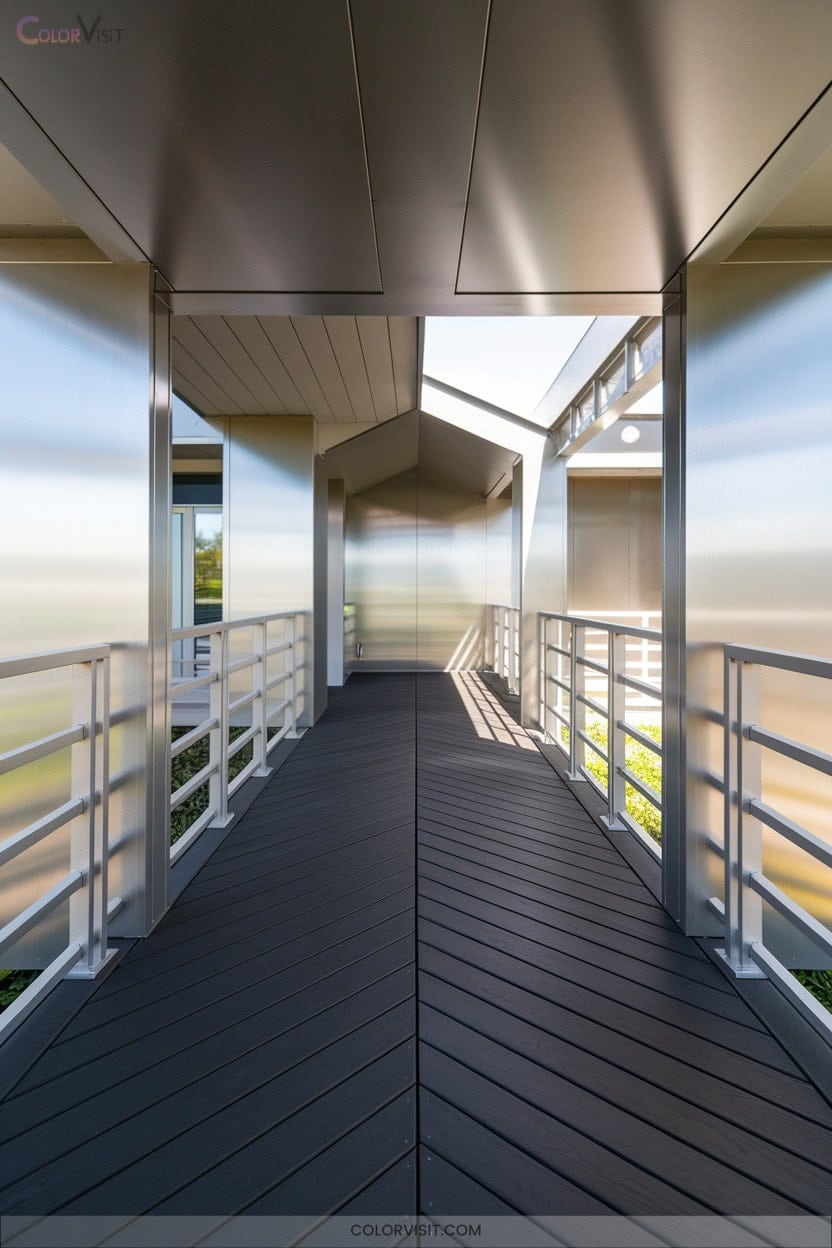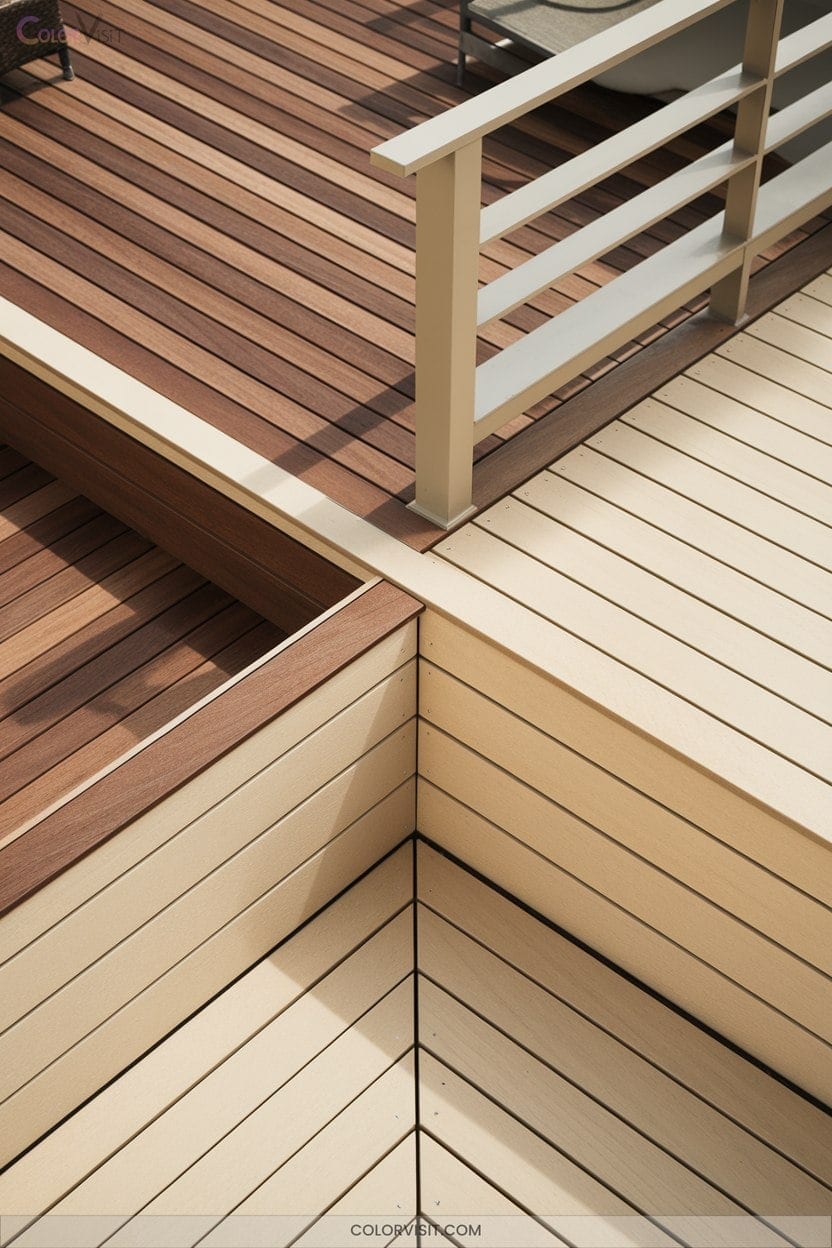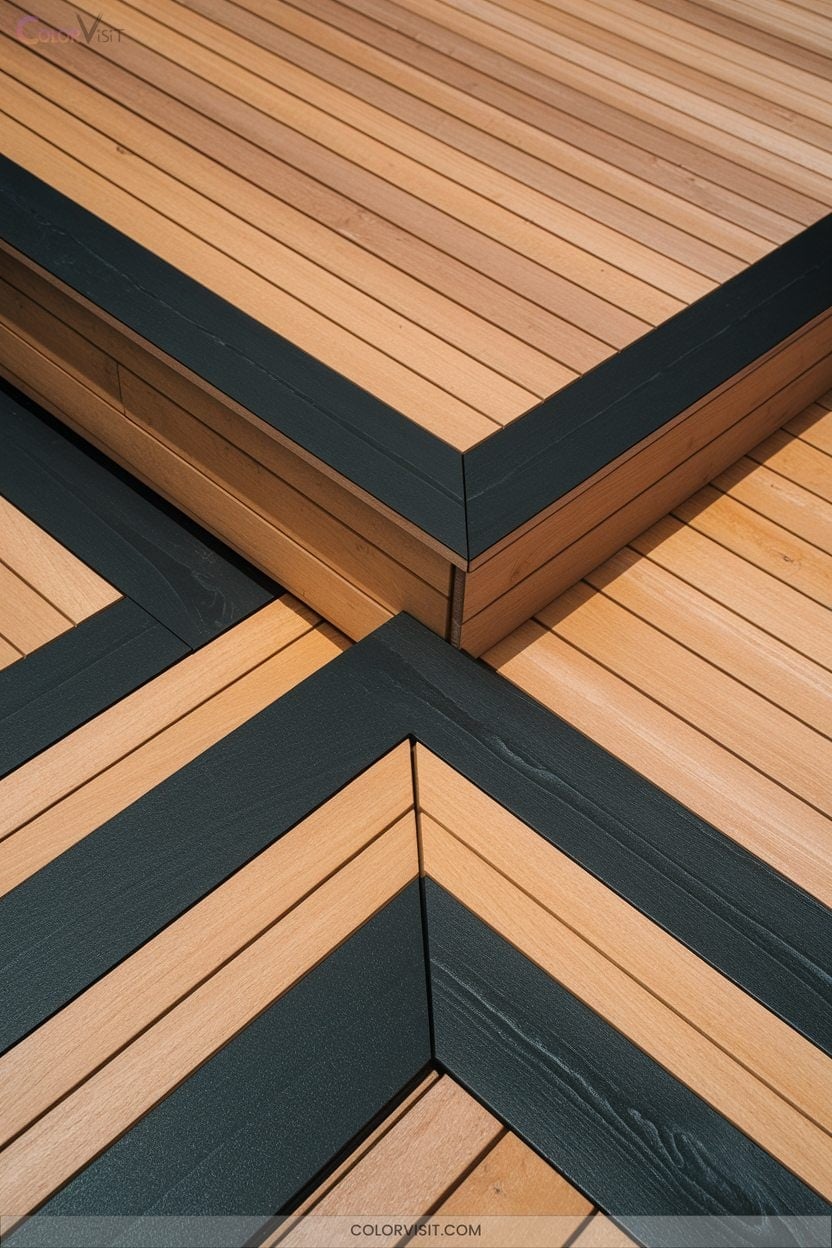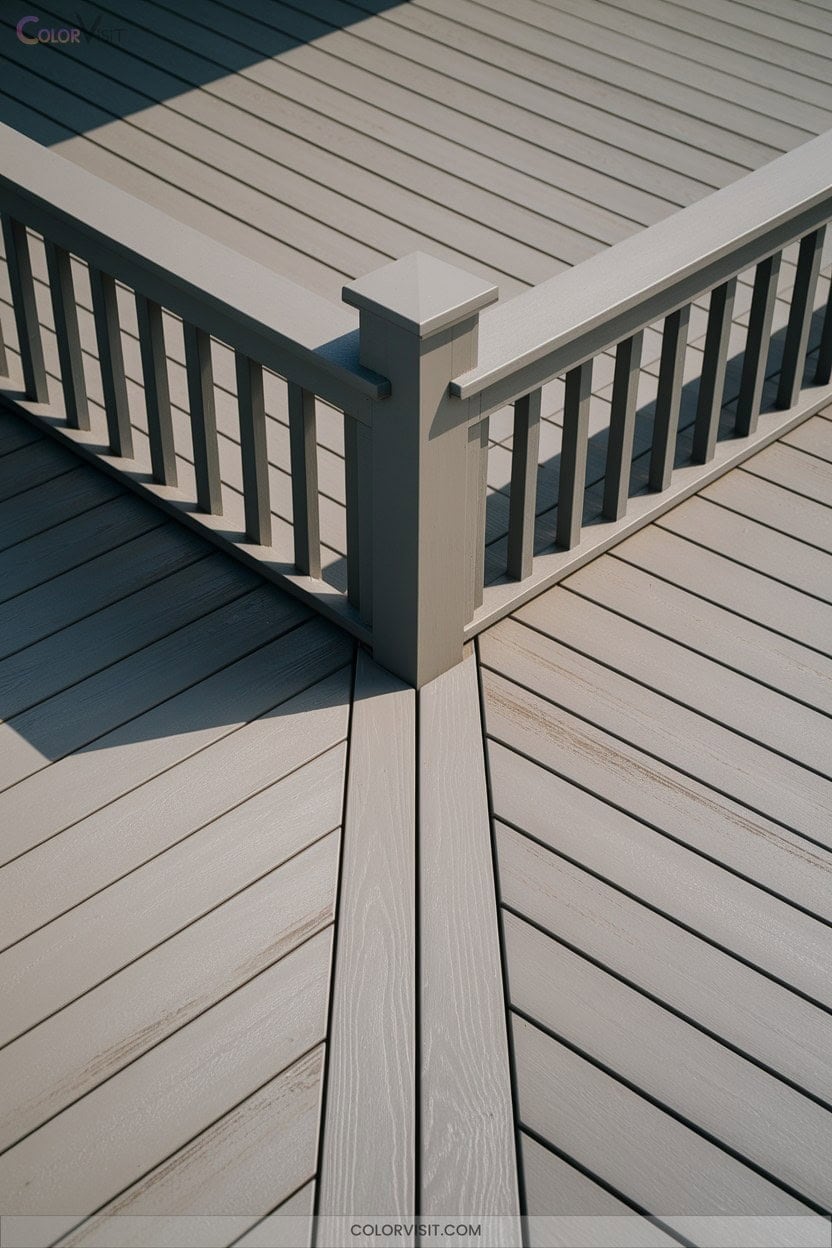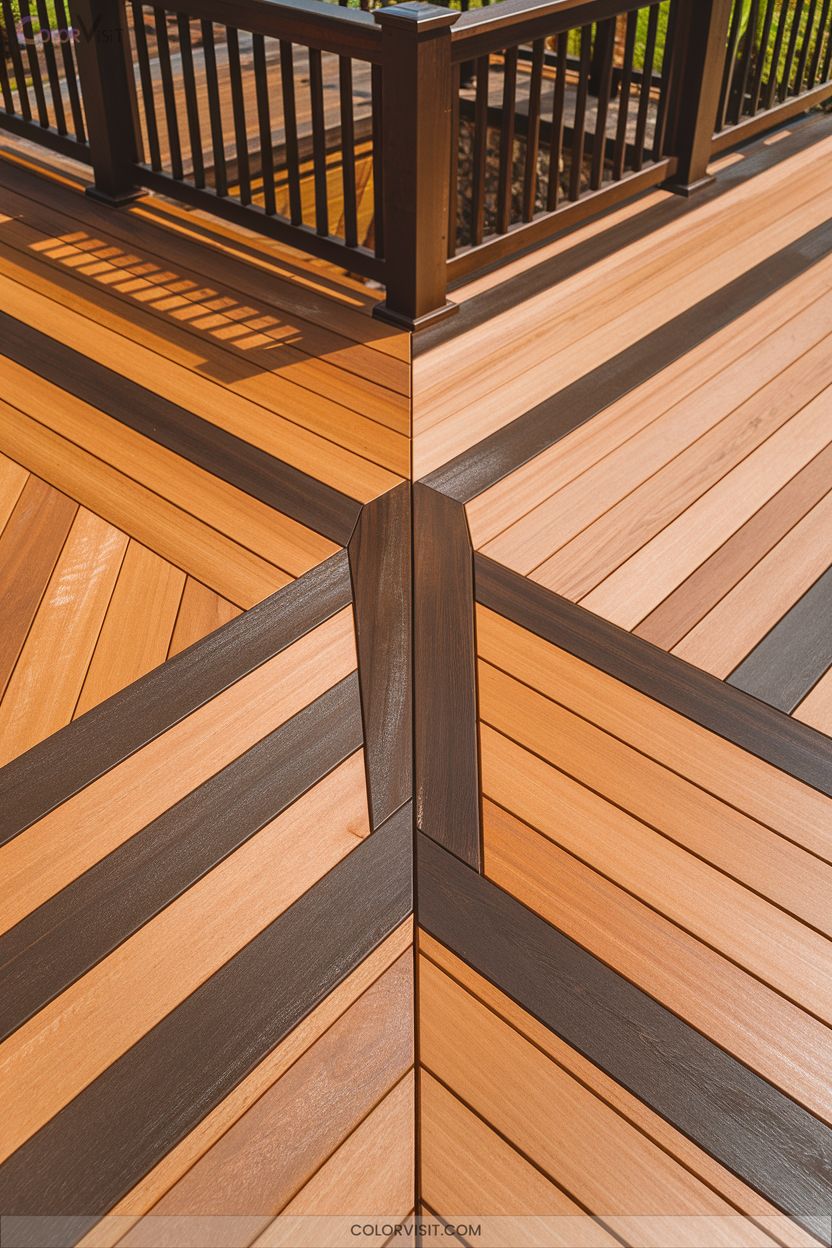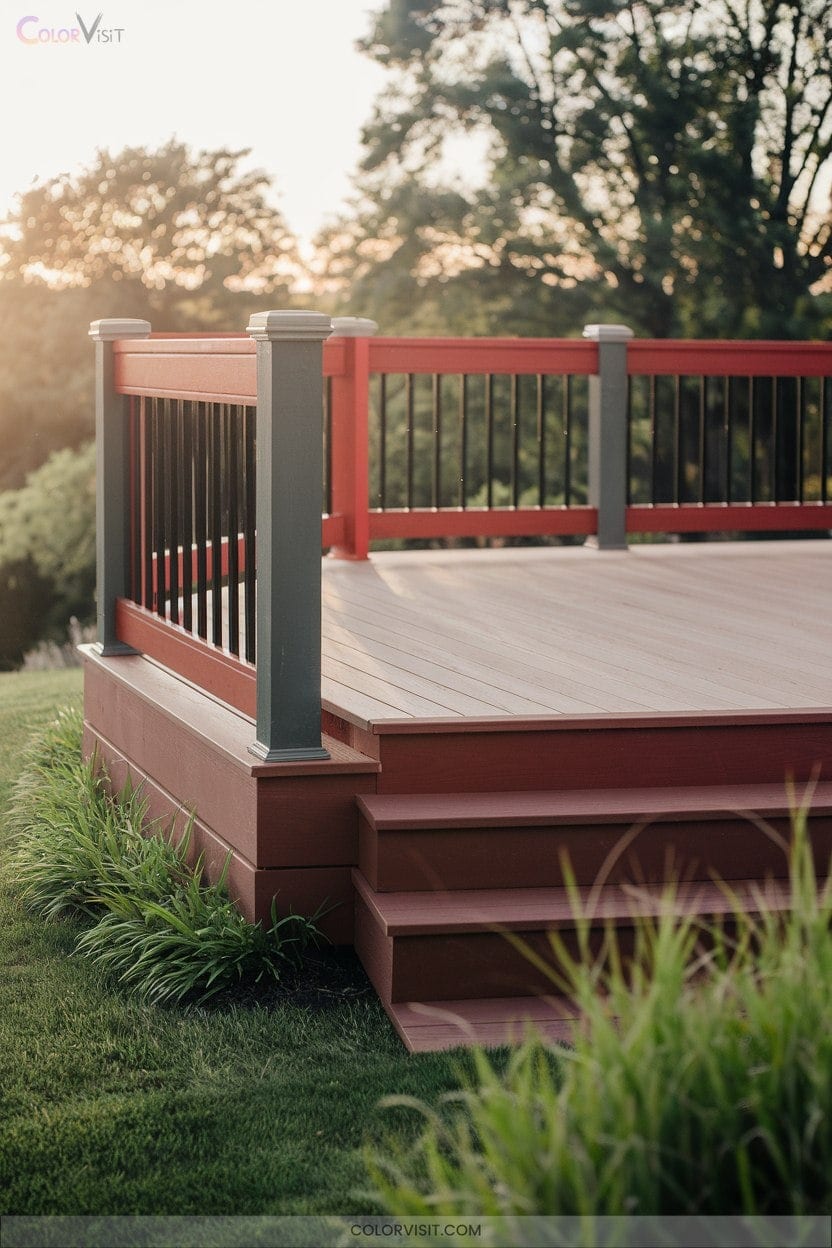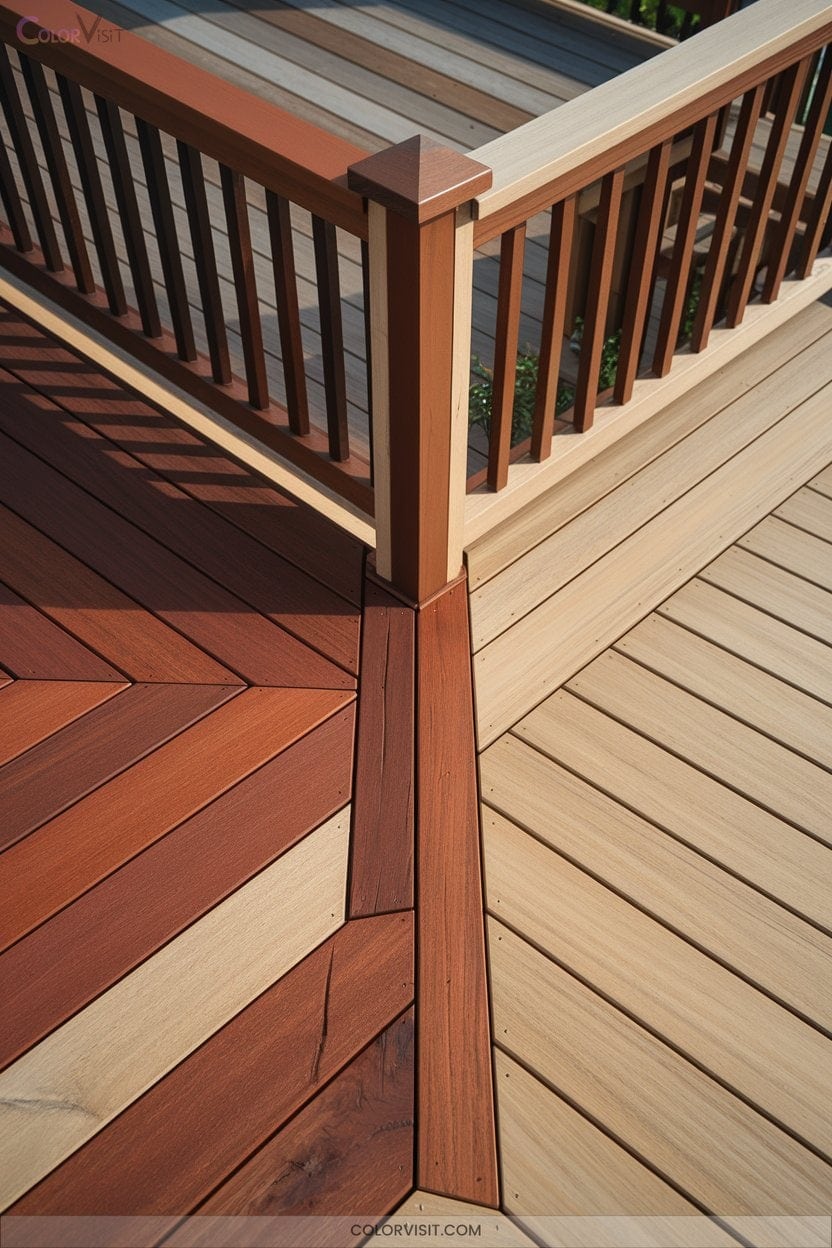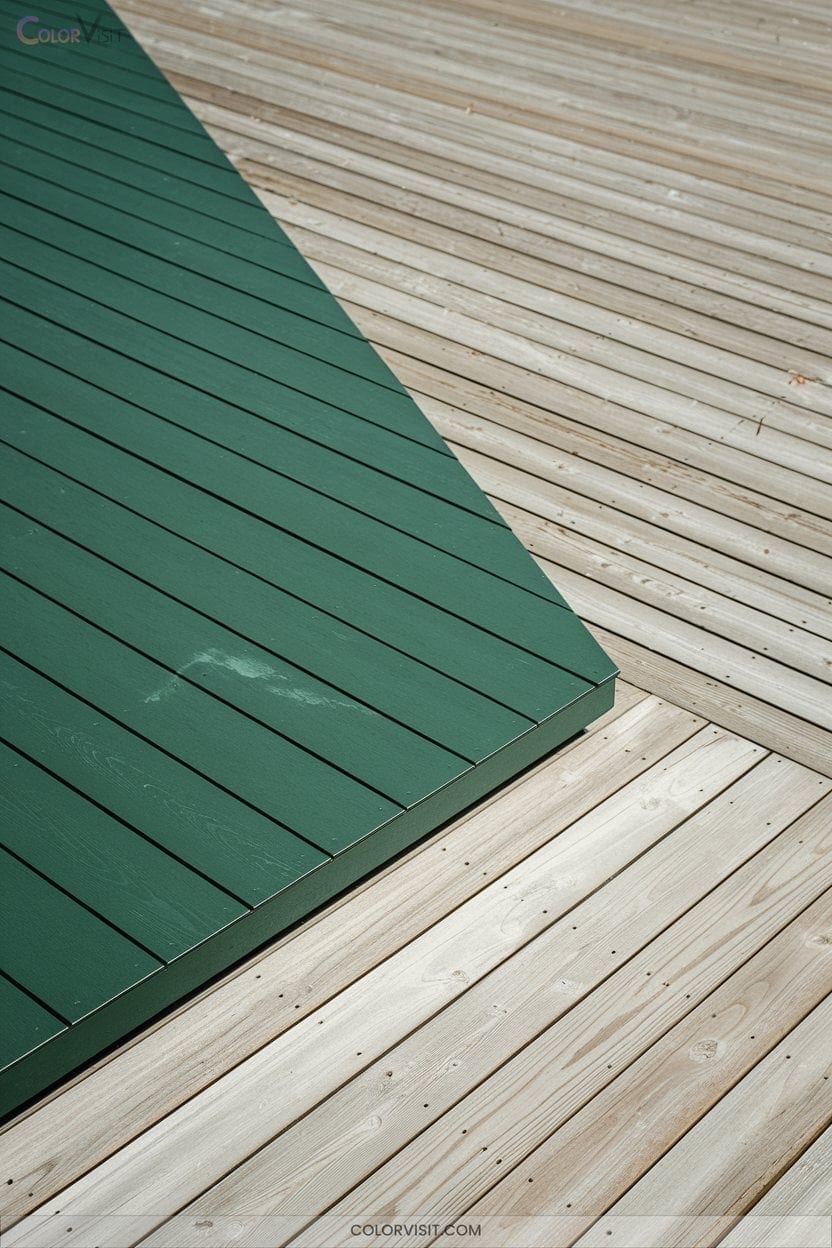14 Striking Two Tone Deck Color Ideas for Dimensional Outdoor Spaces
Elevate your deck by pairing crisp white with gray for a modern vibe, or choose warm light brown against deep brown for cozy depth. Try sleek charcoal with silver for dynamic energy, or contrast bold black borders with warm wood.
Earthy walnut with sand, taupe paired with glossy white, or mahogany and almond combinations add richness. Cool slate with beige, forest green with weathered wood, and thoughtful lighting round out striking two-tone looks—explore fresh combinations just ahead.
1. Modern Gray and White Decking
A modern gray and white deck instantly elevates your outdoor space with crisp lines and a clean, contemporary palette.
Mix various gray shades with sharp white railings or pergolas for sophisticated contrast. Use composite decking for durability and minimal upkeep—perfect for innovative lifestyles. Glass balusters and metal accents boost modernity, while patterned gray boards add texture.
Integrate solar-powered lighting to highlight the palette after dark. Add bold color pops through cushions, planters, or art for flexibility. Opt for white or light furniture to maintain cohesion.
This design adapts easily, blending resilience, style, and customization for a truly standout deck.
2. Classic Light Brown With Dark Brown Accents
Embrace timeless charm by pairing classic light brown decking with rich dark brown accents for a warm and inviting outdoor retreat. This color harmony achieves a balanced, cozy ambiance while infusing visual depth and dimension into your deck.
Define seating zones or highlight railings and stairs with dark brown to organize and frame your space. Experiment with textured, mixed boards and strategic breaker boards for organic flow.
Choose materials—wood or composite—with durable stains for enduring, authentic appeal. Integrate ambient lighting to accentuate contrast, and complement with earthy planters or sculptures.
This versatile palette adapts beautifully to any season and surrounding landscape.
3. Sleek Charcoal and Silver Tones
Sleek sophistication defines a deck finished in charcoal and silver tones, instantly elevating your outdoor space with contemporary flair.
Charcoal’s cool depth anchors your deck, while silver accents reflect light and inject dynamic energy.
Use silver railings, balusters, or inlays to create visual balance and highlight architectural lines.
Opt for weather-resistant stains and durable metal finishes to guarantee longevity and easy maintenance.
Integrate silver-toned lighting to emphasize the modern aesthetic and enhance evening ambiance.
Experiment with matte charcoal and polished silver textures for tactile interest, and consider gradated charcoal shades to maintain a harmonious, monochromatic look that feels cutting-edge.
4. Earthy Walnut and Sand Combinations
Earthy walnut and sand deck color combinations ground your outdoor living space in warmth and natural elegance.
Pair rich walnut planks with lighter sand or taupe accents for striking dimension and seamless landscape integration.
Light walnut offers subtle orange-brown warmth, while beige or tan sand tones harmonize with modern furniture and lush greenery.
For a custom look, balance these hues to echo your home’s siding and trim.
Use composite materials for low-maintenance innovation and durability.
Semi-transparent walnut stains preserve natural grain, while lighter sand colors help reflect heat.
This palette adapts beautifully to seasonal changes and evolving outdoor styles.
5. Bold Black Borders With Warm Wood
A bold black border paired with warm wood instantly transforms your deck into a visually striking and well-defined outdoor retreat.
To maximize this innovative two-tone look, focus on crisp lines and intentional contrasts that highlight the architectural character of your space.
Black borders frame the perimeter, enhance dimensionality, and offer a contemporary edge without sacrificing warmth or comfort.
Black deck borders create striking definition and contemporary style while preserving the inviting warmth and comfort of natural wood.
- Frame the deck with composite black fascia for long-lasting, sharp definition.
- Select rich, warm wood or composite boards—think honey or golden brown—for the main surface.
- Balance border width to avoid visual heaviness.
- Integrate matching black accents in railings or furniture for cohesion.
6. Elegant Ash Gray With Driftwood Highlights
Transform your deck into a serene retreat by combining elegant ash gray boards with driftwood highlights for a look that’s both refined and grounded in nature.
Ash gray creates an earthy, modern base that blends effortlessly with lush surroundings and varied architectural styles.
Add driftwood highlights to railings or inlaid sections for silvery contrast, amplifying depth and visual interest.
Both colors resist wear, hide dirt, and perform beautifully under different lighting.
Their cool undertones stay comfortable in sunlight and harmonize with greenery, water features, and contemporary or classic décor.
This innovative pairing guarantees timeless style and low-maintenance practicality year-round.
7. Warm Cedar With Espresso Trim
Contrast defines the allure of a warm cedar deck accented with espresso trim—rich, red-toned boards set off by deep, dark edges for a look that’s both welcoming and bold.
This pairing creates a harmonious, nature-inspired palette that’s visually dynamic and versatile.
Use espresso trim to define deck zones or highlight architectural features for added dimension. With composite materials, you’ll boost durability and reduce upkeep.
Embrace pattern play for modern edge.
- Use espresso trim for borders and steps to create crisp, visual lines.
- Highlight built-in seating or planters with espresso accents.
- Mix laying patterns for custom appeal.
- Opt for sustainable materials.
8. Coastal Blue and Soft Gray Pairings
Nothing refreshes an outdoor space quite like the combination of coastal blue and soft gray decking.
Pairing a soft gray base with coastal blue accents instantly evokes a breezy, modern vibe perfect for nautical and beach-inspired themes.
Opt for durable composite decking or eco-friendly wood finishes to guarantee lasting color and minimal upkeep.
Use white trim or black railings for bold contrast, and layer natural fiber furniture for texture.
Complement the palette with sandy neutrals and seaglass green for a seamless flow to landscaping.
Always harmonize these hues with your home’s exterior to achieve sophisticated, innovative visual cohesion.
9. Rustic Red and Deep Brown Contrasts
A rich palette of rustic red and deep brown instantly infuses your deck with warmth and inviting character.
Embrace the synergy of these two tones to create a cozy, nature-inspired retreat that stands out with visual depth.
Select natural wood for authenticity, and let the contrast mimic autumnal landscapes while remaining adaptable to both rustic and sophisticated themes.
For best results, balance color harmony and enhance durability with smart design choices.
- Opt for Sherwin-Williams Rustic Red with a grounding deep brown border.
- Integrate copper accents or planters for sophistication.
- Use warm white lighting to highlight depth.
- Maintain with regular sealing.
10. Natural Oak With Slate Gray Details
When you pair natural oak with slate gray details, your deck immediately gains a sophisticated, modern edge while retaining the organic warmth of wood.
This harmonious contrast delivers visual depth—oak’s golden hues glow against the cool, refined gray, creating a dynamic, yet balanced look.
Highlight railings, steps, or built-in seating with slate gray for standout accents.
Use stain on oak to showcase natural grain, and opt for painted or composite gray for sleek surfaces.
This palette adapts seamlessly to seasonal décor and architectural styles, resists weathering, and integrates effortlessly with exterior features—offering durability, low maintenance, and lasting curb appeal.
11. Contemporary Taupe With Crisp White Edges
Shifting from the rich interplay of oak and gray, consider the modern appeal of a taupe deck accented with crisp white edges.
Taupe’s versatile neutrality—whether warm or cool—creates a serene canvas, while sharp white borders inject fresh dimension and clarity.
This pairing amplifies geometry, enhances outdoor lighting, and aligns seamlessly with contemporary minimalist trends.
For a forward-thinking deck design, visualize these strategies:
- Use white composite trim for lasting, sharp boundaries.
- Opt for matte taupe boards with glossy white edges for tactile contrast.
- Layer with natural materials like stone to add depth.
- Highlight pathways with strategic white edging.
12. Mahogany and Almond for Rich Depth
Embrace the striking contrast of mahogany and almond to bring rich depth and elegance to your deck. Mahogany’s deep, reddish-brown warmth pairs seamlessly with almond’s soft, airy tones, creating a visually dynamic and cohesive outdoor space.
Alternate these hues in herringbone or chevron patterns for bold, geometric impact, or define zones with sectional contrasts.
Integrate lush greenery and neutral furnishings to amplify the natural harmony.
Prioritize durable, sustainably sourced materials and apply regular sealing to preserve vibrancy.
Opt for warm lighting to accentuate mahogany’s richness and almond’s subtlety.
This combination delivers innovation, sophistication, and timeless appeal to any deck design.
13. Cool Slate With Warm Beige Accents
Contrast defines a stunning deck, and pairing cool slate with warm beige accents delivers both sophistication and comfort.
This dynamic duo blends modern elegance with a welcoming, nature-inspired vibe.
Use the interplay of temperature and tone to enhance visual depth and seasonal adaptability.
Maximize the effect by strategically placing colors and layering textures.
Here’s how you can innovate with this palette:
- Stagger cool slate and warm beige boards for dimensional patterns.
- Highlight railings or steps with beige accents to draw the eye.
- Integrate subtle lighting to amplify color contrast.
- Mix materials—think composite slate planks with natural beige wood.
14. Forest Green and Weathered Wood Harmony
While cool slate and warm beige offer refined contrast, forest green and weathered wood bring a grounded, organic feel to your deck design.
Pair forest green’s rich, natural tone with the rustic texture of weathered wood for striking visual depth.
Use weathered wood as your primary decking and integrate forest green as railings or borders for dimension and harmony.
Let weathered wood set the stage, while forest green railings or borders add depth and harmonious contrast to your deck design.
Select composite materials for lower upkeep and longevity.
In hot climates, lean toward lighter wood tones to minimize heat.
Accentuate with UV-resistant finishes and monochromatic green or brown accents.
Finish with natural elements—planters, stone, or warm lighting—for innovative, cohesive outdoor appeal.
Frequently Asked Questions
Are Two-Tone Decks More Expensive Than Single-Color Decks?
Yes, you’ll pay more for a two-tone deck—usually about 30% extra. Expect higher labor charges for crisp lines, color changes, and intricate patterns. Prioritize skilled painters and budget for extra time if you want bold, innovative designs.
How Do I Maintain the Color of My Two-Tone Deck Over Time?
You’ll maintain your two-tone deck’s vibrant contrast by sweeping regularly, washing with gentle soap, and spot-treating stains. Reapply semi-transparent stains every 2-3 years, match colors carefully, and inspect annually to keep your design looking sharp and innovative.
Can I Update an Existing Deck to a Two-Tone Design?
Absolutely—you can transform your existing deck into a two-tone masterpiece that’ll turn heads from miles away. Use complementary colors, update railings, and incorporate patterned borders for instant visual drama. Choose durable materials for a long-lasting, innovative finish.
Do Two-Tone Decks Get Hotter in the Sun Than Single-Color Decks?
You’ll notice two-tone decks don’t always get hotter than single-color ones; it depends on your color choices. Combine lighter, reflective shades with darker accents to minimize heat buildup and create a visually dynamic, comfortable outdoor experience.
What Is the Best Way to Clean a Two-Tone Composite Deck?
Imagine revealing a masterpiece—start by clearing your deck’s canvas, then sweep, inspect, and select a pH-neutral cleaner. Scrub section by section, rinse thoroughly, and let sunlight do the drying. Test spots first; precision keeps innovation shining.
Conclusion
Picture yourself stepping onto a deck where contrasting tones dance beneath your feet—sleek charcoals meet crisp whites, warm woods frame cool grays. These two-tone deck color ideas don’t just add style; they carve out visual depth and personality in your outdoor space.
Don’t shy away from bold borders or subtle accents—embrace combinations that reflect your style. With the right pairing, your deck transforms from ordinary to extraordinary, inviting you—and your guests—to linger a little longer.




